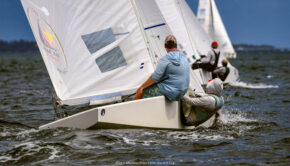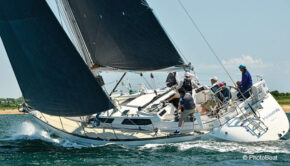Celebrating a Long Tradition of Women Sailors
Published on April 6th, 2015
by Deborah Bennett Elfers
In the February, 2015 issue of Sailing Magazine, Nicholas Hayes wrote that “The fastest growing and most active group entering sailing is made up of active outdoorsy adult women, who eventually bring their friends and family.” It’s his opinion that these women are embracing sailing because of their personal networks and the social benefits that sailing can offer.
As a woman who has come to sailing in my adult life, and who, along with like-minded friends, has committed to it deeply, I would most definitely agree.
Given the demographic data, some Sailing Clubs are beginning to establish programs for women, and Mr. Hayes’s research will likely influence more of them to do so. However, some Clubs have been supporting their women sailors for many years, notably among them the Beverly Yacht Club, based in Marion, Massachusetts.
Beverly has a long tradition of encouraging their women sailors, and as far back as the early 1900s, Beverly’s records show that the not only were ladies racing right alongside the men, but they were also winning! And later, in 1915, when the Club’s fleet of Herreshoff Twelves first began racing, there were female skippers competing right from the get-go. They, too, very often won. In fact, the venerable Herreshoff fleet is the reason that there is an official Ladies’ Racing Series at the Club today.
The Beverly Yacht Club’s Ladies’ Racing Series results first officially appear in the 1946 yearbook, but there is some speculation that the Series had been going on even earlier than that, during the war years when official racing activities and regattas were suspended. It’s important to recognize, too, that in addition to Club racing, over the years the ladies of Beverly have compiled an impressive record in outside racing, as well. Let’s just say that I’m proud to be a Beverly lady. Having raced weekly since 1946, the long-established Beverly’s Ladies’ Racing fleet will celebrate its 70th birthday next year, in 2016.
What makes the Ladies’ Series such a beloved part of the Club’s racing? In part, I think it’s because of our long history, where, over time, we have been able to develop a fleet culture that is committed to supporting growth and improvement, all within the context of a truly competitive racing series. There are skippers in the fleet who have been racing for 70 years, sailing alongside newer racers who are striving to improve their skills — and it’s this combination of differing abilities that gives us a wonderful diversity, setting the stage for important mentoring relationships to unfold.
Additionally, each week on race day there are two races: first, a scored “skipper’s race,” followed by an unscored “crew race” — the latter of which is our secret weapon. It’s most definitely this second race that is the key to the fleet’s success, because it affords an actual racing situation in which a more experienced sailor can coach a newer sailor through the course. And lest you think otherwise, just because it’s not a scored race, doesn’t mean it’s not competitive! Many of our skippers have come through the ranks this way, growing our fleet, and passing on important traditions down through the generations.
But perhaps we are most successful because we are different from many Clubs with programs that are newly and specifically “designed for women.” Because in addition to our Ladies’ Racing Series, we ladies also race in the traditional Sunday Series — with the Beverly men. Begun in 1915, this much older racing series for the Herreshoff fleet has always been one in which men and women actively compete with one another; the men and women of Beverly have been racing these boats together and against each other for 100 years.
Following the tradition of encouraging women to race, our Club also supports a Women’s Keelboat Racing Program, founded nearly 20 years ago, which trains women to work as teams on the J-24, with the ultimate goal of having them race in the Club’s J-24 Series Races. Personally, I believe that segregating men and women can sometimes be helpful for training purposes, where perhaps some women may lag behind men in skippering skills, but that keeping them segregated, and never having the experience of racing together, would be a huge loss for everyone.
Weight differences aside, small boat racing is one of the few sports where men and women can be equally competitive, and plus, it raises the bar just that much higher for both, as men and women can and do bring different perspectives on tactics and risk to the racecourse. I believe that these differences can make us all better sailors.
In 1966, the Beverly Bullseye fleet’s women sailors officially joined the Herreshoff fleet in the Ladies’ Series, and they have been sharing the race course with the Twelves since then, with separate races. On any given Thursday afternoon, you’ll see the Race Committee boat headed out to the outer harbor, followed by 20 teams of ladies (2 per boat), all of them eager and ready to race.
We have a roster of crew that the two fleets share, and service on the Race Committee boat is often a starting point for those new to racing. We offer rules seminars and tactics talks, we meet after racing to discuss what worked and what didn’t, and we are all committed to supporting each other in our work together.
Why does it work so well? Quite simply, and most importantly, because we are a community. We have a unique and long history of coming together around our shared passion of sailing, and our experiences together help to bind us ever more closely with each passing year. After all, 70 years is a long time, isn’t it?
Thanks to Deborah for sharing her article with Scuttlebutt Sailing News.









 We’ll keep your information safe.
We’ll keep your information safe.